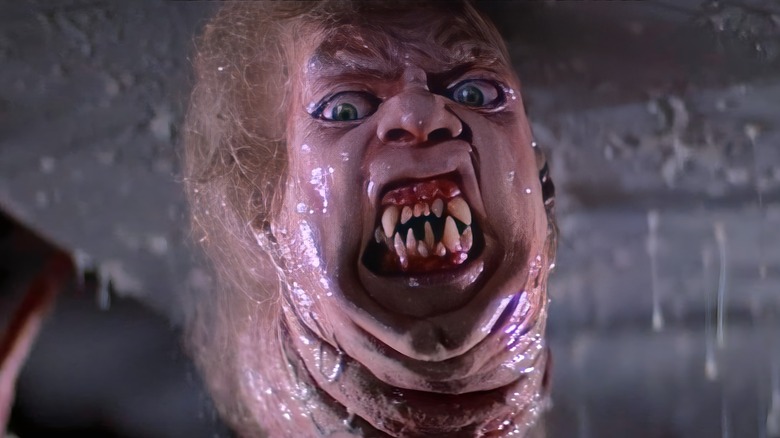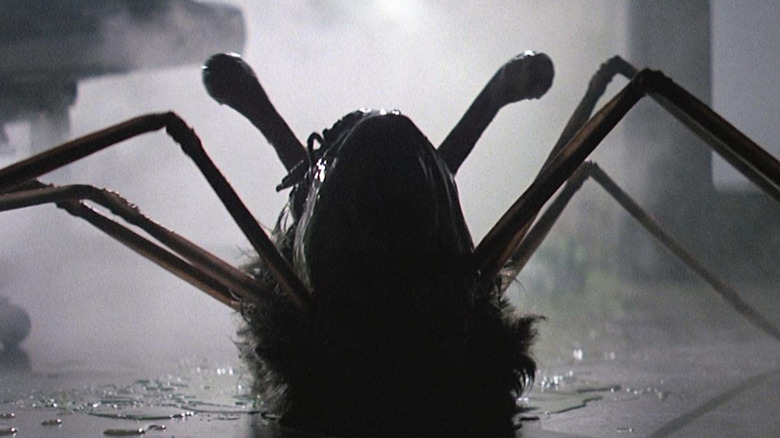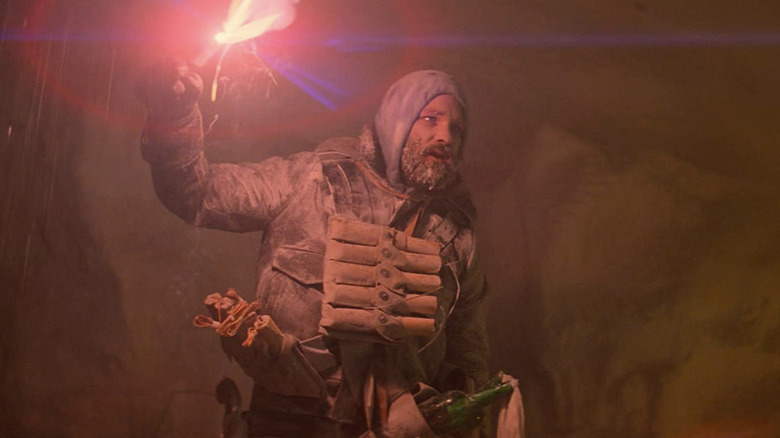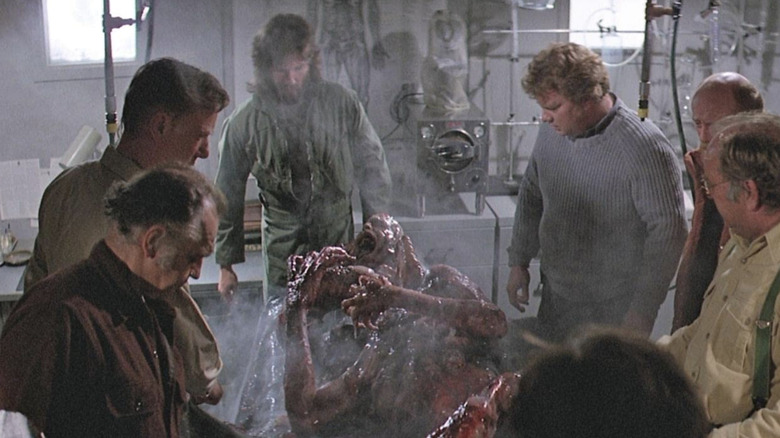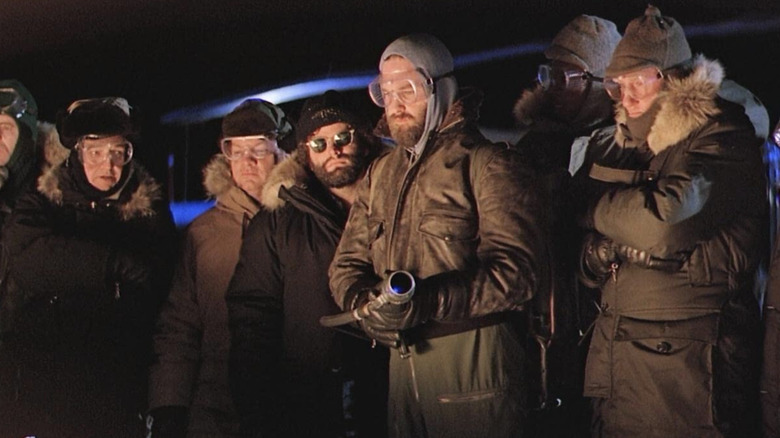John Carpenter's Thing 2 Needs To Be About COVID Or It's A Complete Waste Of Time
See, here's the thing. It takes a lot for any creative talent to revisit a classic beloved by so many, especially when their previous work is so universally admired. It's doubly hard when someone else already tried to follow up on your work, and failed. Props to John Carpenter, then, for daring to trek back to Outpost 31 and revisit his most nightmarish creation.
Yes, that's right — if you haven't heard it yet, Carpenter is fully invested in making a sequel to his 1982 film "The Thing." He reaffirmed his commitment to this in 2023, after being asked for the gazillionth time if MacReady (Kurt Russell) or Childs (Keith David) had survived the attack following that iconic cliffhanger. According to Creepy Catalog, he said, "I have been sworn to secrecy, okay because there may be, I don't know if there will be, there may be a 'Thing 2.'"
If a "The Thing" sequel comes to pass, though, it needs to follow in the multi-limbed footsteps of its predecessor, and remold this otherworldly enemy from the inside-out, just like how the prior movie was so radically different from 1951's "The Thing from Another World." As Carpenter previous shifted the space beast from an ogre-like monster to shape-shifting nightmare fuel, a future installment needs to evolve with the times and confront the fears of a modern audience. That does not mean dousing it in glitzy CGI — definitely not — but instead, recreating how the first film was a mirror for fears of its time.
What we're saying, point-blank, is that "The Thing 2" needs to be about COVID-19, and its predecessor sets it up perfectly to do just that.
The Thing is a creature of change, and COVID is its next evolutionary step
Much like the creature that plagues this lonely band of men, Carpenter's "The Thing" is an amorphous allegory of multiple fears of that era. On the base level, the simple nightmare of an enemy among us resonated thanks to the distrust present from the Cold War, colliding with growing knowledge of AIDS. Kurt Russell and his worn-down rabble are battling a foe that looks like a friend, echoing the insecurities that were felt from the Red Scare and the Doomsday Clock. Meanwhile, the growth of a real-life epidemic magnified the horror of a threat that attacked us from the inside: don't forget how one of the film's most frightening moments is that copper wire blood test.
In 1981, the world was weary of threats it couldn't see, potential extinctions it couldn't prepare for, and an unknown viral killer — one we didn't understand — that led to widespread doubt and discrimination. Sound familiar?
This is why for "The Thing 2," channeling the dread of the COVID-19 pandemic seems almost inevitable. However, the subtext here should be very intentional, because the anxieties created by COVID are familiar but different. In a "Thing" sequel, the terror should replicate the way that real-life COVID caused not just paranoia, but social pressure — and ruptures in society when people didn't necessarily take the precautions that experts told them to.
A Thing sequel needs to focus on how COVID ruptured society
In the 2020s, sci-fi stories about societal collapse hit harder than they used to. Pandemic-themed shows like "The Last of Us" linger in our minds longer than they would have before. Keeping this in mind, any story that involves a virus or extraterrestrial — much less some merging of the two — gets under our skin in a very, very real way, which is precisely why now is the right time for Carpenter to come back to "The Thing" — but again, only if he's foregrounding parallels to COVID-19.
The paranoia and tension of wondering if someone is the Thing? That's a breeze for the filmmaker, and "The Thing" already did that well enough. A sequel, now, needs to further complicate that with aspects like the nature of lockdown, social pressures, and conspiracy theories.
Consider, for instance, how "The Thing 2" could focus on characters slowly realizing that they aren't who they believe themselves to be: remember, the original film explains that "imitations" replicate the organism they've absorbed, right down to the belief that they think they're still human. This creates a perfect parallel for COVID, considering how the real-life pandemic led to widespread conspiracy theories and vaccine denialism, as well as people fighting against social distancing precautions designed to protect them. On film, having characters assert for control of the situation, only to learn they lost control long before — and are, in turn, spreading the Thing to others — makes for an unsettling and wildly different angle than the original film.
These themes would hit even harder if Carpenter swapped out the setting of a small outpost in Antarctica for something larger.
The Thing 2 should go hard and go home
It's not hard to believe Carpenter could turn the fear factor up to 11, just as he did the last time around, simply by replicating the first film's brilliant setting. Again, though, there's no purpose to a sequel if it only repeats the past. Consider how the 2011 prequel simply felt like a CGI retread, and it makes this argument easy.
Instead, Carpenter should leave us squirming in our seats by putting the Thing in a space that's bigger than Outpost 31. Isolation is still the key, but a different kind — the kind that breeds in a communal area, like a small town in a wintery location, which has multiple families living in multiple houses, but miles upon miles away from the rest of the world. In other words, let's take some inspiration from David Slade's "30 Days of Night," capture those same chills, and see how multiple different families react to something invading their home, while handling increasingly tense stand-offs with their neighbors.
Carpenter could pull this off like nobody else. This man gave us cinema's top-tier home invader, Michael Myers, after all. When you add in his legendary multi-legged beastie, and have it bring a small town to its knees, it would leave an impact that would ripple through audiences even after they left the theater.
The Thing 2 must tap into our current fears, or they shouldn't bother
Should this sequel come to fruition, it's doubtful that it will take a heartless route and mine a worldwide tragedy for cheap thrills. That really isn't Carpenter's style. Instead, "The Thing 2" should go the way all great horrors do — as "Get Out" does, and as its predecessor did — and hold a twisted mirror to the audience. A mirror that shows what can happen when a deadly invader (like a virus) infiltrates a group, and how paranoia and denial spreads just as contagiously. Discomfort is the point. COVID impacted all of us, and a slightly less direct approach like this — instead of a conventional pandemic movie — will hit harder.
Let's be honest. Hollywood has already tried to bring our recent experiences to the big screen with the likes of "Songbird," which met a massively negative reception. So, we should leave this subject matter to a filmmaker who is a master of his genre, and already hit on the anxieties of the early 1980s so perfectly in the past.
Sure, "The Thing 2" can have all the mad monster effects that audiences would love to see again. But at the same time, just like its titular terror, "The Thing 2" should deliver something that unsettles us on a deeper level. After all, it's what's underneath that counts.
